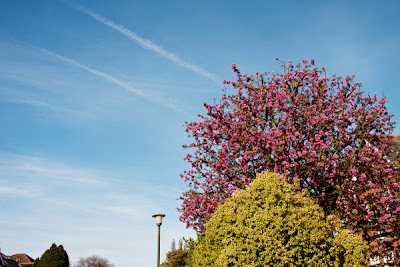Paul Graham is currently showing at the Whitechapel Gallery in London. In a retrospective of his work several large rooms are filled with photographs made between 1981 and 2006. Starting with the beautiful "television portraits" , moving through Europe, Japan and America , he immerses himself in the landscapes and unconscious rituals of societies.
As the gallery describes "The everyday scenarios he reflects are also embedded with a complex iconography. The hand that an immaculately made up Japanese girl waves across her mouth evokes a society anxiously over-invested in surfaces."
Under a hot grey Pittsburgh sky, an African American gardener mows the grass verge of a car park, traversing back and forth, going nowhere. This is from one of the series in "A shimmer of possibility", which I found the most beautiful of his works. In this quiet series , which Graham describes as "filmic Haiku" , he finds beauty in everyday events as they unfold before his eyes. Here is man who finds beauty in the ordinary, but who is also able to point out the contrasts of those who have and those who have not.
The way that this series was presented was of particular interest to me; seven or so different sized images conveying the same scene from different perspectives and in different sizes, are displayed as a whole that conveys not only time passing, but also person and place, in a poetic way that befits the term Haiku.
Also of interest was the series of bespoke books made to contain the series;
A shimmer of possibility , published by SteidlMACK
These are bound in brightly coloured cloth, each one a different colour. The volumes range between relatively extended passages of more than twenty photographs over sixty pages, to a book that cradles just one picture, a story with no beginning and no end.
David Chandler says of "A Shimmer of Possibility" on the Paul Graham archive
"Graham has said that a shimmer of possibility was in part inspired by Chekhov’s short stories, which achieve the greatest atmosphere from ordinary situations, the most vivid sense of time, place and character, with the most minimal of means, and with plain words beautifully arranged often in long lilting sentences.
Whilst too literal a comparison would be unhelpful, Graham’s photographic sequences do have a Chekhovian pace and phrasing, one that makes effective use of the pause – in Graham’s case blank pages between images – and that strikes a balance between formlessness and structure.
In the Shimmer books, formless photographs, or perhaps more accurately photographs where form is incidental, are variously sized and irregularly placed on the page but in carefully planned succession. The sudden shifts of subject and viewpoint and the use of repetition deliberately dislodge the narrative flow but also allow us to share in Graham’s watchful fascination. Virginia Woolf, in her essay ‘Tchehov’s Questions’, noted something similar in Chekhov’s ‘choice of incidents and endings’ that unsettle the reader, giving the impression ‘that the ground upon which we expected to make safe landing has been twitched from under us.’ But somehow, she argued, things imperceptibly ‘arrange themselves, and we come to feel that the horizon is much wider from this point of view; we have gained an astonishing sense of freedom."
He quotes from Chekov, relating it to another group in the series , of a gas station and events therein while the sun is setting...
‘And when he was crossing the river on the ferry, and then when he was walking up the hill, looking down at his own village and across to the west, where the cold crimson sunset was glowing in a narrow band, he realised that truth and beauty, which had guided human life in that garden and at the high priest’s, had continued to do so without a break until the present day, and had clearly always constituted the most important elements in human life, and on earth in general; and a feeling of youth, health, and strength – he was only twenty two years old – and an inexpressibly sweet expectation of happiness, of unfathomable, mysterious happiness, gradually overcame him, and life seemed entrancing and miraculous to him, and full of sublime meaning.'
Anton Chekov, The Student
We are back in the realms of beauty, albeit of a different kind; beauty found in suburbia, as a reflection of everyday routines and chance
The enormous scale of many of the images is striking; some are 2-3metres high/wide, reaching from floor to ceiling. My only criticism of the exhibition is the lack of printed information to accompany the works; admittedly the exhibition is free, but £35 for a catalogue is not within everyone's budget.
All of the works are framed in beautiful box frames, either white, occasionally plain wood and also black. I wonder how they are transported, as box frames are much more vulnerable to damage as the glass is not close to the solid back, but floats in front.
It is an exhibition to impress, and to provoke. I recommend it.









